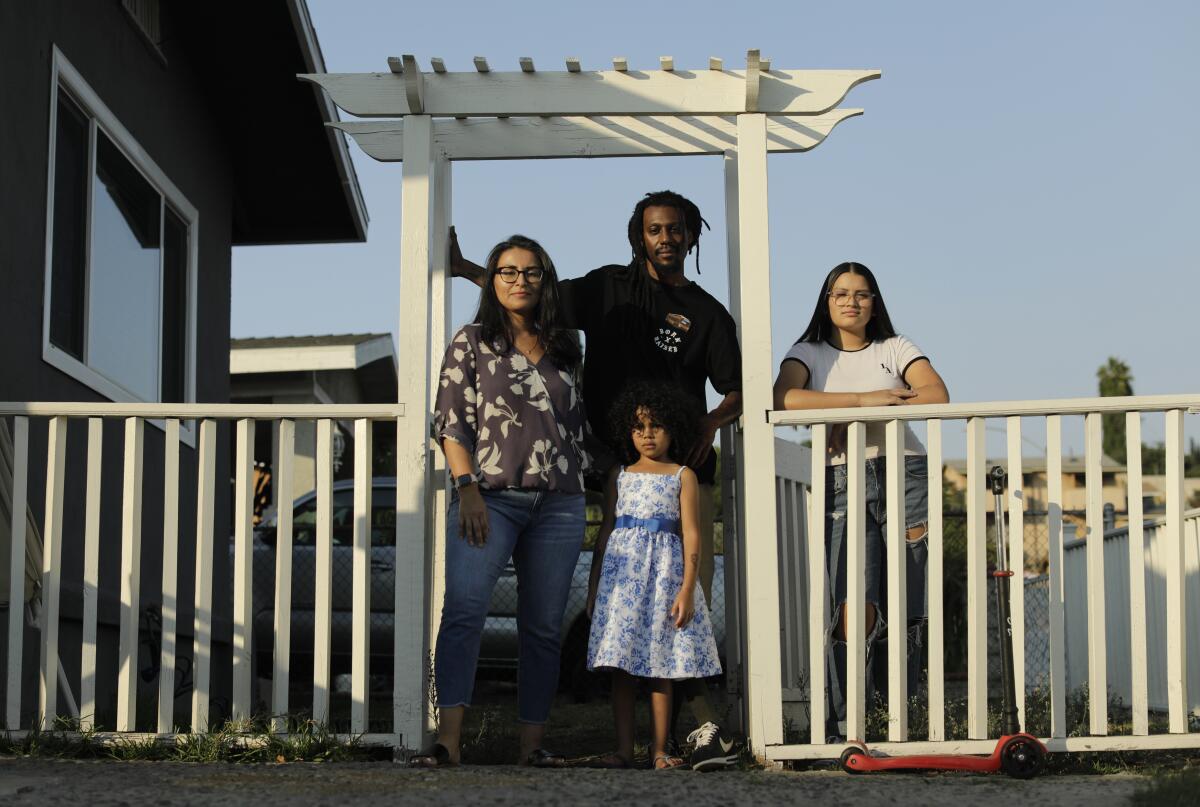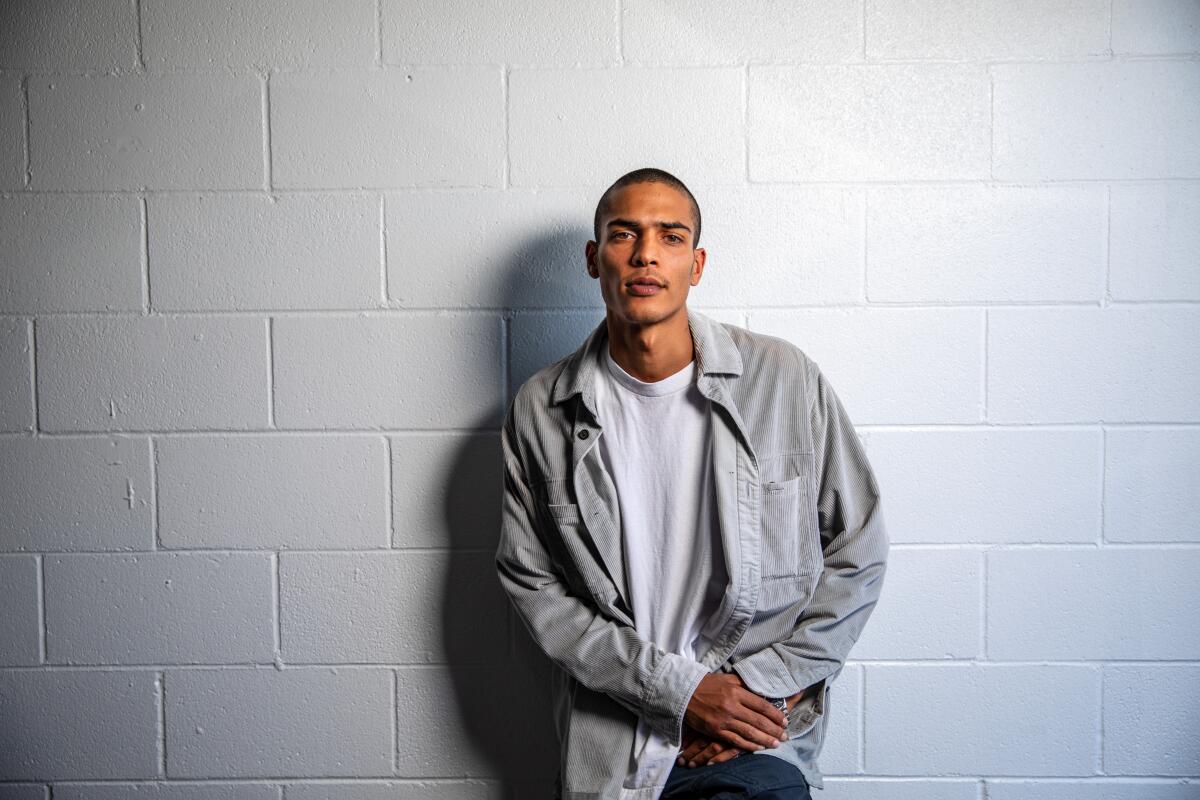A pandemic, protests, identity: Being both Black and Latino in 2020 is a juggling act

- Share via
After the killing of George Floyd by Minneapolis police, Nandi Zavala urged her Instagram followers to sign petitions and attend Black Lives Matter protests.
As a Black woman, Zavala felt a personal responsibility to do this. As a Mexican American woman, she was also anxious: Would the Latino side of her family think she was ignoring her other half?
Zavala, whose mother is Black and father is from Mexico, mined Instagram for pro-immigration infographics and anything else she could share to demonstrate solidarity with Latinos.
She felt an internal pressure to “balance out” her social media feed.
“I want people to know that I am these things, and I’m proud to be these things, because they’ve all shaped who I am as a person now,” said Zavala, 21, a student taking the semester off because of the pandemic.
Zavala and others with both Black and Latino heritage have been performing this cultural juggling act all their lives. Now, with one crisis in public health and another in police brutality, the shared struggles, as well as the misunderstandings, between the two cultures have moved front of mind.
The challenges faced by Black and Latino people in this time of illness and protest overlap significantly. Coronavirus has killed them at disproportionately high rates. Poverty, crowded housing and chronic health issues were already more prevalent in their communities. Many have lost their jobs or are essential workers braving hazardous conditions.
In L.A. County, they also bear the brunt of police violence — 80% of those killed by law enforcement in the last two decades were Black or Latino.
But some mixed-race people say the lifetime effort to bridge the gap between their two halves has intensified in recent months, particularly in helping the Latino side understand what it’s like to be Black.
They have fielded questions from family members, such as, “Why have the peaceful protests turned violent?”
With the new focus on racial accountability, they are also more determined to address the anti-Blackness coming from some friends and relatives, which can necessitate conversations including “No, you can’t say the N-word” and “Stop making offensive comments about my hair.”
The pressure to explain, and the pain of seeing people like them in so many devastating situations, has made a stressful time even more stressful.
And there is the existential issue of feeling once again in the middle: “Where do I fit in?”
With interracial marriage in the U.S. on the rise — from 3% of couples in 1967, when the U.S. Supreme Court decided the landmark Loving case, to 17% in 2015 — more young people are wrestling with these issues.
Ebony Bailey’s Mexican American mother, a hair stylist, was told this summer by a Latino client: “I know that your husband is Black and that your kids are Black … but I think people are marching for nothing. Slavery was a long time ago.”
Growing up in the conservative central California town of Porterville, which is two-thirds Latino with few Black residents, Bailey was singled out for her dark skin and Black features. She tried to prove to her peers that she had Mexican roots, too.
Now, she feels validated by the number of Latino people supporting the Black Lives Matter movement. In Mexico City, where Bailey lives, she has attended and spoken at protests against police brutality, where people held up signs that said “Tu lucha es mi lucha” — your fight is my fight.
According to a poll by the New York Times and Siena College, 21% of Latino voters said they marched in support of Black Lives Matter — nearly identical to the 22% of Black voters who said they did.
“I’m an incarnation of Black and brown unity,” said Bailey, 29, a filmmaker who formerly worked for The Times as a web producer.
As the COVID-19 pandemic escalated, Bailey worried about her parents, who still live in Porterville and have underlying medical conditions.
Her dad worked in a chicken factory before stopping out of fear for his safety. Her mom was unemployed for several months before returning to her salon in September.
With the physical and financial well-being of both their cultures threatened at the same time, some mixed people feel hit by a double whammy.
“That’s the burden of being Black and brown,” said Bailey, 29. “If it’s not something with health, then it’s something with your economics. You’re not in a safe space through the pandemic.”
Like Bailey, Zavala grew up in a community with few other Black people.
She often got comments about her tight curls. “It looks like you have spiders in your hair,” a relative once said in Spanish.
She had to explain to Latino family and friends that just because they were people of color didn’t mean they had a pass to say the N-word, even when the intent wasn’t racist.
Conversely, her Black classmates wondered if she was adopted when her tía picked her up from school in Lakewood.
She has found herself doing a lot more explaining this year.
A cousin said he didn’t understand why people were breaking into stores during what were supposed to be peaceful protests.
That set off a series of discussions, with Zavala explaining the genesis of the movement. While it was about George Floyd, there was also pain in the Black community that spanned centuries, she told her cousin.
“For someone who doesn’t necessarily understand what it’s like [being Black and] seeing Black people in the headlines all the time being killed or injured, it feels less serious if you can’t relate to it,” she said.
After learning more about police brutality against other Black people, including the killing of Breonna Taylor in Louisville, Ky., the cousin wrote to Zavala: “I get it. It’s [messed up] that this keeps happening.”
There are particular joys that come with being bicultural. Zavala points to her playlist, where Houston rapper Megan Thee Stallion and Guadalajaran rock en español band Maná coexist in harmony.
But the last few months have been exhausting, between curating her social media posts to reflect both sides of her heritage, explaining Black struggle to Latino family members and keeping track of developments in both worlds.

Growing up mixed in the mostly Black and Latino neighborhood of Willowbrook, near Compton, Geron McKinley recognized a common thread in both of his cultures, which have been oppressed but remained proud.
But some of his own family members couldn’t see the similarities. Sometimes, they brought up stereotypes in front of him, as if they had forgotten that he is both races.
His usual response was to bluntly remind them that they were talking about him — and in the case of his mom’s Mexican family, some of his cousins who are also part Black.
“As mixed people, it’s our job almost to be correcting our family,” McKinley said. “And if you’re not correcting your family, you’re letting them perpetuate stereotypes. You’re part of the problem.”
As for law enforcement, they see him as a threat, no matter how they peg his race.
In the L.A. area, Latino officers are common, making up about half of both the Los Angeles Police Department and the L.A. County Sheriff’s Department. But there are relatively few Black officers patrolling neighborhoods with large Black populations, where relationships with law enforcement are the most fraught.
“ ‘He’s either Black or he’s Mexican. Either way, get him,’ ” said McKinley, 25, a model and founder of a clothing brand and nonprofit called Concreet, which offers sports, arts, music and entrepreneurship programs for children.
After the events of this year, McKinley is even more determined to support both Black and Latino causes.
“Now more than ever, even if I’ve felt like I’m not Black enough to be Black or I’m not Mexican enough to be Mexican, if either side needs me to ride, then I’m riding,” he said.
For parents of mixed Black and Latino children, passing on knowledge and pride about both cultures can be a challenge that now feels even more crucial.
Since their daughter Soul was born five years ago, Alma Zaragoza-Petty and Jason Petty have engaged in a good-humored rivalry, reflected in the wall decorations — both African masks and Lotería-style prints — in their Boyle Heights home.
Zaragoza-Petty, 38, who is Mexican American, advises first-generation college students. Petty, 41, who is Black, is an activist and rapper under the name Propaganda. Together, they host “The Red Couch Podcast,” where they discuss topics including social justice and systemic racism.
Soul may be too young to understand why people are protesting in the streets, but her parents take every chance to underline the richness of her dual heritage.
“The reality is that she has to be prepared for a world that is going to have some feelings and thoughts about her as a mixed Black Latina woman,” Zaragoza-Petty said.
In L.A. County, which is nearly 50% Latino and 8% Black, the future may look something like Soul.
The couple are also raising a 15-year-old daughter, Luna, who is full Latina and from Zaragoza-Petty’s previous relationship, with similar values as her little sister.
Petty believes the world will view Soul as Black, despite being mixed. He is making Black Girl Magic — a movement started by social media influencer and writer CaShawn Thompson that celebrates resilience, beauty and joy in Black women — a key part of her upbringing.
As she prepared to attend a racial justice protest with her parents this summer, Soul made a sign — a heart and some squiggles. It was about the coronavirus.
“I don’t want anyone to get sick,” she said.
More to Read
Sign up for Essential California
The most important California stories and recommendations in your inbox every morning.
You may occasionally receive promotional content from the Los Angeles Times.














